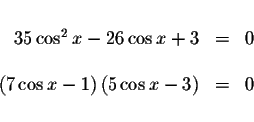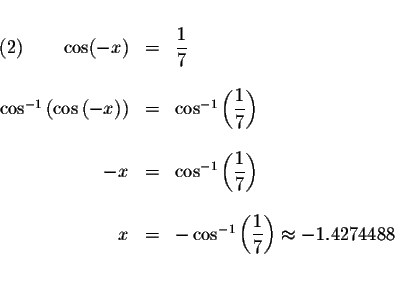
 SOLVING TRIGONOMETRIC EQUATIONS
SOLVING TRIGONOMETRIC EQUATIONS

Note: If you would like a review of trigonometry, click on trigonometry.
Problem 9.7a: Solve for x in the equation
Answer: The exact answers are

where n is an integer.
The approximate values of these solutions are

Solution:
There are an infinite number of solutions to this problem.
In the equation
![]() there are two different
trigonometric terms. To make life easier for yourself, convert the equation
to an equivalent equation in terms of just sine terms or just cosine terms.
Which one shall it be? The easiest way is to convert the trigonometric terms
to cosine terms because from the identity
there are two different
trigonometric terms. To make life easier for yourself, convert the equation
to an equivalent equation in terms of just sine terms or just cosine terms.
Which one shall it be? The easiest way is to convert the trigonometric terms
to cosine terms because from the identity
![]() ,
you can solve for
,
you can solve for
![]() .
Substitute
.
Substitute
![]() for
for
![]() in the original equation.
in the original equation.

Rewrite the equation
![]() in factored form and solve
for
in factored form and solve
for ![]() .
.

The only way the product of two factors equals zero is if at least one of
the factors equals zero. This means that
![]() if
if
![]() or
or
![]()
We have transformed a difficult problem into two less difficult problems. To
find the solutions to the original equation,
![]() ,
we first find the solutions to
,
we first find the solutions to ![]() in the
equations
in the
equations
![]() and
and
![]()


To solve for x, we must isolate x, and just how do we do that? We could take the arccosine of both sides. However, the cosine function is not a one-to-one function.
We can restrict the domain of the function so the function is one-to-one on
the restricted domain while preserving the original range. The cosine
function is one-to-one on the interval
![]() If we
restrict the domain of the cosine function to that interval , we can take
the arccosine of both sides of each equation.
If we
restrict the domain of the cosine function to that interval , we can take
the arccosine of both sides of each equation.

We know that
![]() Therefore, if
Therefore, if
 ,
then
,
then


We complete the problem by solving for the second factor.

We know that
![]() Therefore, if
Therefore, if
 ,
then
,
then


Since the period of ![]() equals
equals ![]() ,
these solutions will repeat
every
,
these solutions will repeat
every ![]() units. The exact solutions are
units. The exact solutions are

where n is an integer.
The approximate values of these solutions are

where n is an integer.
You can check each solution algebraically by substituting the solution in the original equation. If, after the substitution, the left side of the original equation equals the right side of the original equation, the solution is valid.
You can also check the solutions graphically by graphing the function formed by the left side of the original equation and graphing the function formed by the right side of the original equation. The x-coordinates of the points of intersection are the solutions. The right side of the equation is 0 and <tex2htmlcommentmark> f(x)=0 is the x-axis. So really what you are looking for are the x-intercepts to the function formed by the left side of the equation.
Algebraic Check:
Check solution

Left Side:

Right Side: ![]()
Since the left side of the original equation equals the right side of the original equation when you substitute 1.4274488 for x, then 1.4274488 is a solution.
Check solution

Left Side:

Right Side: ![]()
Since the left side of the original equation equals the right side of the original equation when you substitute -1.4274488 for x, then -1.4274488is a solution.
Check solution

Left Side:

Right Side: ![]()
Since the left side of the original equation equals the right side of the original equation when you substitute 0.927295 for x, then 0.927295 is a solution.
Check solution

Left Side:

Right Side: ![]()
Since the left side of the original equation equals the right side of the
original equation when you substitute -0.927295 for x, then -0.927295 is
a solution. We have just verified that the exact solutions are
 and
and
 and these solutions repeat every
and these solutions repeat every ![]() units. The approximate values of these solutions are
units. The approximate values of these solutions are
![]() and
and
![]() and these solutions repeat every
and these solutions repeat every
![]() units.
units.
Graphical Check:
Graph the equation
![]() Note that the graph
crosses the x-axis many times indicating many solutions.
Note that the graph
crosses the x-axis many times indicating many solutions.
Verify the graph crosses the x-axis at -0.927295. Since the period is
![]() ,
the graph also crosses the x-axis again at
<tex2htmlcommentmark>
-0.927295+6.2831853=5.35589 and at
,
the graph also crosses the x-axis again at
<tex2htmlcommentmark>
-0.927295+6.2831853=5.35589 and at
![]() ,
etc.
,
etc.
Verify the graph crosses the x-axis at
![]() .
Since the period is
.
Since the period is
![]() ,
the graph also crosses the x-axis again at
<tex2htmlcommentmark>
0.927295+6.2831853=7.21048 and at
,
the graph also crosses the x-axis again at
<tex2htmlcommentmark>
0.927295+6.2831853=7.21048 and at
![]() ,
etc.
,
etc.
Verify the graph crosses the x-axis at
![]() .
Since the period is
.
Since the period is
![]() ,
the graph also crosses the x-axis again at
<tex2htmlcommentmark>
1.4274488+6.2831853=7.710634 and at
,
the graph also crosses the x-axis again at
<tex2htmlcommentmark>
1.4274488+6.2831853=7.710634 and at
![]() ,
etc.
,
etc.
Verify the graph crosses the x-axis at
![]() .
Since the period is
.
Since the period is
![]() ,
the graph also crosses the x-axis again at
<tex2htmlcommentmark>
-1.4274488+6.2831853=4.8557365 and at
,
the graph also crosses the x-axis again at
<tex2htmlcommentmark>
-1.4274488+6.2831853=4.8557365 and at
![]() ,
etc.
,
etc.
Note: If the problem were to find the solutions in the interval
![]() ,
then you choose those solutions from the set of infinite
solutions that belong to the set
,
then you choose those solutions from the set of infinite
solutions that belong to the set
![]()
![]() and
and
![]()
If you would like to review the solution to another problem, click Back to Solutions and then click on the word solution opposite the problem you want to review.
If you would like to go to the next section, click on Next.
If you would like to go back to the previous section, click on previous.
If you would like to go back to the equation table of contents, click on Contents.

